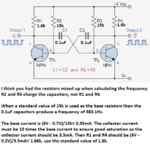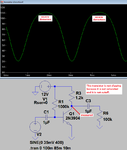wfg42438
Member level 3
- Joined
- Jun 29, 2015
- Messages
- 54
- Helped
- 0
- Reputation
- 0
- Reaction score
- 0
- Trophy points
- 6
- Location
- California
- Activity points
- 620
Hello,
Can someone please explain how to go about choosing the collector resistors for this topology?
Say i want frequency of 500 Hz, then i know that :
If i let C1=C2=0.1uF then i find that R1=R4=14.5k
will provide the needed frequency
For some reason i dont know how to Choose R2=R3
If VCC=5V and VCE=0.3 V (to ensure im in the active region) then VR2=4.7V but how do i determine Ic to choose R2?
Can someone please help out?
These variables are based on the following Diagram
**broken link removed**
Can someone please explain how to go about choosing the collector resistors for this topology?
Say i want frequency of 500 Hz, then i know that :
If i let C1=C2=0.1uF then i find that R1=R4=14.5k
will provide the needed frequency
For some reason i dont know how to Choose R2=R3
If VCC=5V and VCE=0.3 V (to ensure im in the active region) then VR2=4.7V but how do i determine Ic to choose R2?
Can someone please help out?
These variables are based on the following Diagram
**broken link removed**
Last edited by a moderator:




